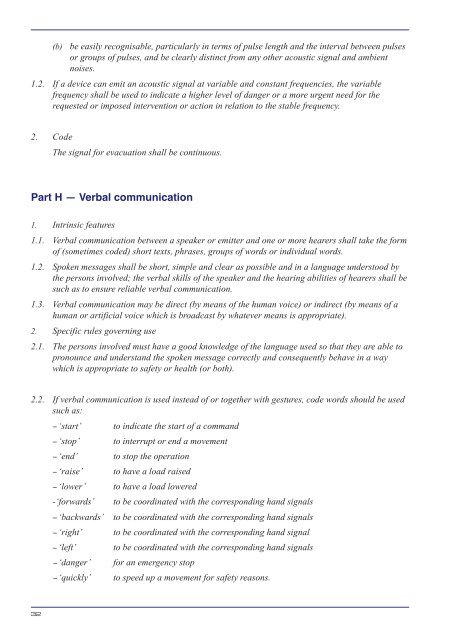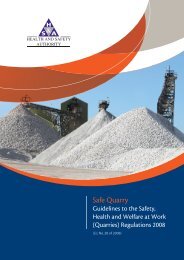Safety Signs at a Place of Work 2010 - Health and Safety Authority
Safety Signs at a Place of Work 2010 - Health and Safety Authority
Safety Signs at a Place of Work 2010 - Health and Safety Authority
Create successful ePaper yourself
Turn your PDF publications into a flip-book with our unique Google optimized e-Paper software.
(b) be easily recognisable, particularly in terms <strong>of</strong> pulse length <strong>and</strong> the interval between pulses<br />
or groups <strong>of</strong> pulses, <strong>and</strong> be clearly distinct from any other acoustic signal <strong>and</strong> ambient<br />
noises.<br />
1.2. If a device can emit an acoustic signal <strong>at</strong> variable <strong>and</strong> constant frequencies, the variable<br />
frequency shall be used to indic<strong>at</strong>e a higher level <strong>of</strong> danger or a more urgent need for the<br />
requested or imposed intervention or action in rel<strong>at</strong>ion to the stable frequency.<br />
2. Code<br />
The signal for evacu<strong>at</strong>ion shall be continuous.<br />
Part H — Verbal communic<strong>at</strong>ion<br />
1. Intrinsic fe<strong>at</strong>ures<br />
1.1. Verbal communic<strong>at</strong>ion between a speaker or emitter <strong>and</strong> one or more hearers shall take the form<br />
<strong>of</strong> (sometimes coded) short texts, phrases, groups <strong>of</strong> words or individual words.<br />
1.2. Spoken messages shall be short, simple <strong>and</strong> clear as possible <strong>and</strong> in a language understood by<br />
the persons involved; the verbal skills <strong>of</strong> the speaker <strong>and</strong> the hearing abilities <strong>of</strong> hearers shall be<br />
such as to ensure reliable verbal communic<strong>at</strong>ion.<br />
1.3. Verbal communic<strong>at</strong>ion may be direct (by means <strong>of</strong> the human voice) or indirect (by means <strong>of</strong> a<br />
human or artificial voice which is broadcast by wh<strong>at</strong>ever means is appropri<strong>at</strong>e).<br />
2. Specific rules governing use<br />
2.1. The persons involved must have a good knowledge <strong>of</strong> the language used so th<strong>at</strong> they are able to<br />
pronounce <strong>and</strong> underst<strong>and</strong> the spoken message correctly <strong>and</strong> consequently behave in a way<br />
which is appropri<strong>at</strong>e to safety or health (or both).<br />
2.2. If verbal communic<strong>at</strong>ion is used instead <strong>of</strong> or together with gestures, code words should be used<br />
such as:<br />
− ‘start’<br />
− ‘stop’<br />
− ‘end’<br />
− ‘raise’<br />
− ‘lower’<br />
-‘forwards’<br />
− ‘backwards’<br />
− ‘right’<br />
− ‘left’<br />
− ‘danger’<br />
− ‘quickly’<br />
to indic<strong>at</strong>e the start <strong>of</strong> a comm<strong>and</strong><br />
to interrupt or end a movement<br />
to stop the oper<strong>at</strong>ion<br />
to have a load raised<br />
to have a load lowered<br />
to be coordin<strong>at</strong>ed with the corresponding h<strong>and</strong> signals<br />
to be coordin<strong>at</strong>ed with the corresponding h<strong>and</strong> signals<br />
to be coordin<strong>at</strong>ed with the corresponding h<strong>and</strong> signal<br />
to be coordin<strong>at</strong>ed with the corresponding h<strong>and</strong> signals<br />
for an emergency stop<br />
to speed up a movement for safety reasons.<br />
32

















